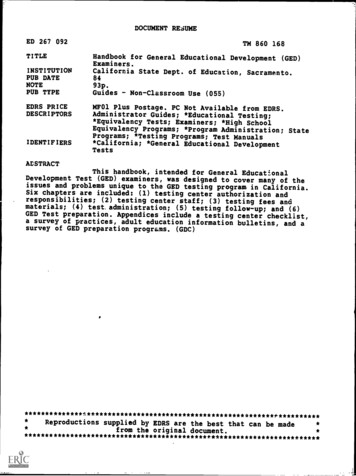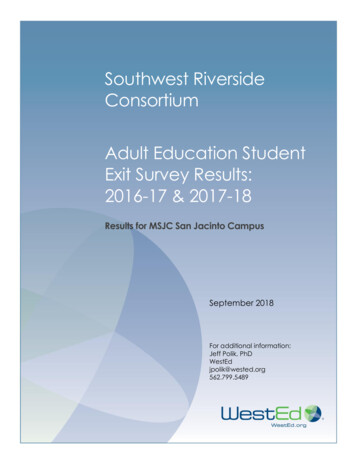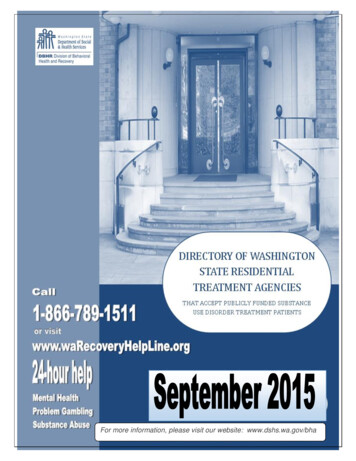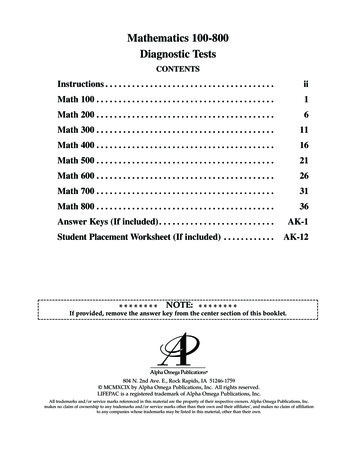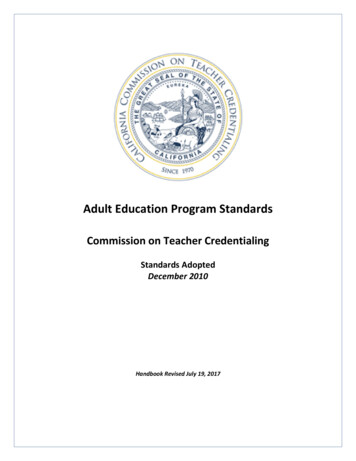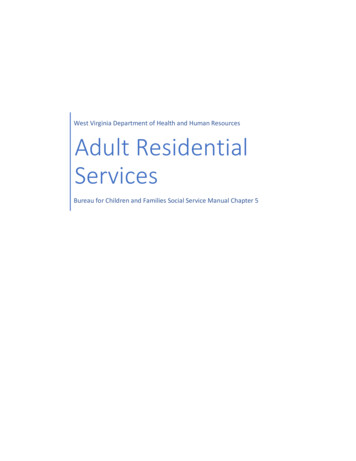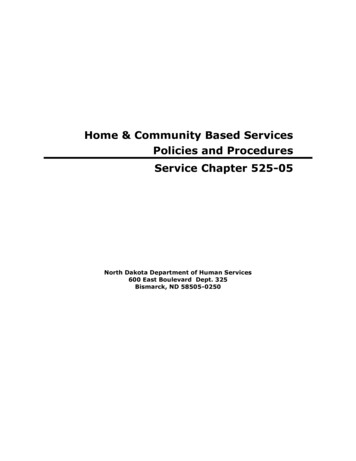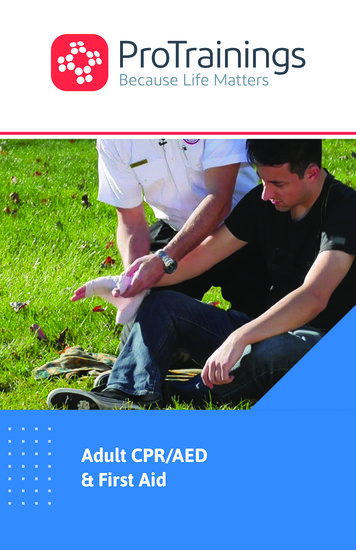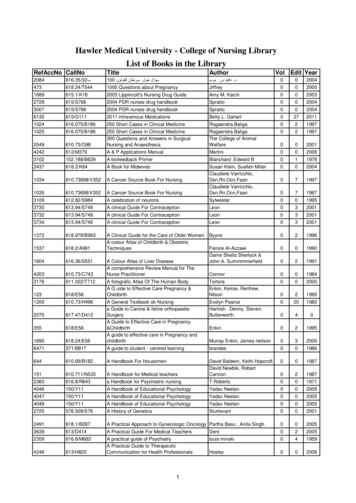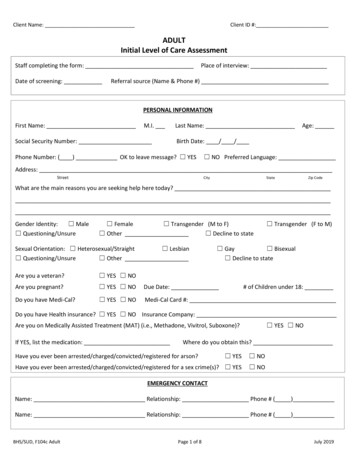
Transcription
Clear FormClient Name:Client ID #:ADULTInitial Level of Care AssessmentStaff completing the form:Date of screening:Place of interview:Referral source (Name & Phone #)PERSONAL INFORMATIONFirst Name:M.I.Social Security Number:Last Name:Age:Birth Date: / /Phone Number: ( ) OK to leave message? YES NO Preferred Language:Address:StreetCityStateZip CodeWhat are the main reasons you are seeking help here today?Gender Identity: Male Questioning/Unsure Female Transgender (M to F) Other Decline to stateSexual Orientation: Heterosexual/Straight Lesbian Questioning/Unsure Other Transgender (F to M) Gay Bisexual Decline to stateAre you a veteran? YES NOAre you pregnant? YES NODue Date:Do you have Medi-Cal? YES NOMedi-Cal Card #:# of Children under 18:Do you have Health insurance? YES NO Insurance Company:Are you on Medically Assisted Treatment (MAT) (i.e., Methadone, Vivitrol, Suboxone)?If YES, list the medication: YES NOWhere do you obtain this?Have you ever been arrested/charged/convicted/registered for arson? YES NOHave you ever been arrested/charged/convicted/registered for a sex crime(s)? YES NOEMERGENCY CONTACTName: Relationship: Phone # ( )Name: Relationship: Phone # ( )BHS/SUD, F104c AdultPage 1 of 8July 2019
Client Name:Primary DrugClient ID #:ALCOHOL AND/OR OTHER DRUG USE# of Days usedRoute of AdmissionAge at first usein past 30 daysDate Last UsedSecondary Drug# of Days usedin past 30 daysRoute of AdmissionAge at first useDate Last UsedTertiary Drug# of Days usedin past 30 daysRoute of AdmissionAge at first useDate Last UsedHave you used needles in the past 12 months? YES NO Decline to state/NAIf yes, last used: / /Date you last used any drugs including alcohol: / / Number of days in a row you have been using:How long do you think you have had a problem with alcohol and/or other drugs?ALCOHOL AND/OR OTHER DRUG TREATMENT HISTORYHave you received treatment for alcohol and/or other drugs in the past? YESIf yes, please give details:Type of Recovery TreatmentName of Treatment Facility(Outpatient, Residential,Detoxification) NODates ofTreatmentTreatmentCompleted(yes or no)ASAM Dimension 1: Acute Intoxication and/or Withdrawal PotentialDo you have a history of serious withdrawal, seizures, or life-threatening symptoms during withdrawal? YES NOIf yes, please describe:Are you currently experiencing withdrawal symptoms, such as tremors, excessive sweating, rapid heart rate, blackouts,anxiety, vomiting, etc.? YES NOIf yes, please describe:BHS/SUD, F104c AdultPage 2 of 8July 2019
Client Name: 0: NoneClient ID #:Severity Rating – Dimension 1 (Substance Use, Acute Intoxication, Withdrawal Potential)COUNSELOR: Please Check one of the following levels of severity 1: Mild 2: Moderate 3: Significant 4: SevereFully functioning, no signs ofintoxication or W/D present.Mild to moderateintoxication interfereswith daily functioning,but does not pose adanger to self/others.Minimal risk of severeW/D.Intoxication may besevere, but responds tosupport; not posing adanger to self orothers. Moderate riskof severe W/D.Severe signs/symptomsof intoxication indicatean imminent danger toself/others. Risk ofsevere but manageableW/D; or W/D isworsening.Incapacitated, withsevere signs/symptoms.Severe W/D presentsdanger, such asseizures. Continued useposes an imminentthreat to life (e.g., liverfailure, GI bleeding, orfetal death).ASAM Dimension 2: Biomedical Conditions/Complications(Include review of Health Questionnaire and TB Questionnaire in your determination below)Are you currently taking prescription medications for any medical conditions? YES NO If yes, please describe:If recently enrolled in Medi-Cal, have you received a health screening to identify health needs within 90 days ofMedi-Cal enrollment? YES No N/A 0: NoneFully functioning andable to cope with anyphysical discomfort orpain.Severity Rating – Dimension 2 (Biomedical Conditions and Complications)COUNSELOR: Please Check one of the following levels of severity 1: Mild 2: Moderate 3: SignificantAdequate ability to copewith physical discomfort.Mild to moderatesymptoms (such as mild tomoderate pain) interferewith daily functioning.Some difficulty toleratingphysical problems. Acute,non-life threateningmedical symptoms (such asacute episodes of chronic,distracting pain, or signs ofmalnutrition or electrolyteimbalance) are present.Serious biomedicalproblems are neglected.Poor ability to tolerateand cope with physicalproblems, and/orgeneral health conditionis poor. Serious medicalproblems neglectedduring outpatient or IOTservices. Severemedical problems (suchas severe pain requiringmedication, or hard tocontrol Type 1 Diabetes)are present but stable. 4: SevereThe person isincapacitated, withsevere medicalproblems (such asextreme pain,uncontrolled diabetes,GI bleeding, or infectionrequiring IV antibiotics).*Note: For residential programs, if the risk rating on ASAM Dimension 2 is greater than “zero” (0), please submit thecompleted Health Screening Questionnaire along with this form to assist with obtaining initial authorization.BHS/SUD, F104c AdultPage 3 of 8July 2019
Client Name:Client ID #:ASAM Dimension 3: Emotional/Behavioral/Cognitive Conditions/ComplicationsReview Risk Assessment and Co-Occurring Conditions Screening form for historical information relevant to this dimension.Include as part of your assessment of severity, below.Do you have any current thoughts of hurting yourself or others? YES NO If yes, please describe:Are you currently being treated or sought help in the past for a mental health condition? (For example, depression,bipolar disorder, anxiety, PTSD, psychosis, or other mental health condition). YES NOIf yes, please describe:If yes to the question above, are you currently prescribed medications for the mental health condition(s) you described? YES NOIf yes, please describe:Do you feel like you are unable to care for yourself (hygiene, food, clothing, shelter, etc.)? YES NOIf yes, please describe:Do you currently have a therapist and/or psychiatrist? YES NOIf yes, provide name/contact information:Over the past 2 weeks, how often have you been bothered by any of the following problems? Feeling down, depressed or hopeless Not at all Several Days More Than Half the Days Nearly Every Day Needed much less sleep than usual and found you didn’t really miss it Not at all Several Days More Than Half the Days Nearly Every Day Feeling nervous, anxious, or on edge Not at all Several Days More Than Half the Days Nearly Every Day Had nightmares about a frightening, horrible or upsetting event you’ve experienced Not at all Several Days More Than Half the Days Nearly Every Day Seen things that other people can’t see or don’t seem to see Not at all Several Days More Than Half the Days Nearly Every Day Heard things that other people can’t hear or don’t seem to hear Not at all Several Days More Than Half the Days Nearly Every DaySeverity Rating – Dimension 3 (Emotional, Behavioral or Cognitive (EBC) Conditions or Complications)COUNSELOR: Please Check one of the following levels of severity 0: None 1: Mild 2: Moderate 3: Significant 4: SevereGood impulse control,coping skills and subdomains(dangerousness/lethality,interference withrecovery efforts, socialfunctioning, self-careability, course of illness).BHS/SUD, F104c AdultThere is a suspected ordiagnosed EBC conditionthat requiresintervention, but doesnot significantlyinterfere withtreatment. Relationshipsare being impaired butnot endangered bysubstance use.Persistent EBCcondition, withsymptoms that distractfrom recovery efforts,but are not animmediate threat tosafety and do notprevent independentfunctioning.Page 4 of 8Severe EBCsymptomatology, butsufficient control thatdoes not requireinvoluntary confinement.Impulses to harmself/others, but notdangerous in a 24-hr.setting.Severe EBC symptomatology;requires involuntaryconfinement. Exhibits severeand acute life-threateningsymptoms (e.g., dangerous orimpulsive behavior orcognitive functioning) posingimminent danger toself/others.July 2019
Client Name:Client ID #:ASAM Dimension 4: Readiness to ChangeHow long do you think you have had a problem with alcohol and/or other drugs?Have you tried to stop drinking/using before? If so, what interfered with your success with that goal?Do you intend to reduce or quit drinking/using in the next 2 weeks? Definitely no Probably no Probably yes Definitely yesWhat substance(s) are you willing to stop using?What would be helpful for you now in order to change your drinking/using?What is the possibility 12 months from now you will not have a problem with alcohol and/or other drugs? Definitely not Probably not Probably will Definitely willHow important is it for you to receive treatment for:Alcohol problems: Not at all Slightly Moderately Considerably ExtremelyDrug problems: Considerably Extremely Not at all 0: NoneEngaged in treatment as aproactive, responsibleparticipant. Committedto change.BHS/SUD, F104c Adult Slightly ModeratelySeverity Rating – Dimension 4 (Readiness to Change)COUNSELOR: Please Check one of the following levels of severity 1: Mild 2: Moderate 3: SignificantAmbivalent of the need tochange. Willing to exploreneed for treatment andstrategies to reduce or stopsubstance use. May believeit will not be difficult tochange, or does not accepta full recovery treatmentplan.Reluctant to agree totreatment. Able toarticulate negativeconsequences (ofsubstance use and/ormental healthproblems) but has lowcommitment to change.Passively involved intreatment (variablefollow through, variableattendance)Page 5 of 8Minimal awareness ofneed to change. Onlypartially able to followthrough withtreatmentrecommendations. 4: SevereUnable to follow through,little or no awareness ofproblems, knows very littleabout addiction, sees noconnection betweensubstance use/consequences.Not willing to explorechange. Unwilling/unable tofollow through withtreatment recommendations.July 2019
Client Name:Client ID #:ASAM Dimension 5: Relapse, Continued Use, or Continued Problem PotentialWhat’s the longest period of time that you have gone without using alcohol and/or other drugs?If you previously stopped using alcohol and/or other drugs, what are the reasons you started using again?“Triggers” are events, feelings, people, places or things that cause someone to justify using again. Are you aware of yourtriggers to use alcohol and/or other drugs? YES NOIf yes, please list:What are some coping tools you have used in the past to avoid using? 0: NoneSeverity Rating – Dimension 5 (Relapse, Continued Use, or Continued Problem Potential)Please Check one of the following levels of severity 1: Mild 2: Moderate 3: Significant 4: SevereLow or no potential forfurther substance useproblems or has lowrelapse potential. Goodcoping skills in place.BHS/SUD, F104c AdultMinimal relapse potential.Some risk, but fair copingand relapse preventionskills.Impaired recognition andunderstanding ofsubstance use relapseissues. Able to selfmanage with prompting.Page 6 of 8Little recognition andunderstanding of relapseissues, poor skills tocope with relapse.Repeated treatmentepisodes have had littlepositive effect onfunctioning. No copingskills forrelapse/addictionproblems. Substanceuse/behavior placesself/others in imminentdanger.July 2019
Client Name:ASAM Dimension 6: Recovery EnvironmentAre you homeless or at risk? YES NOAre you currently employed?Client ID #:Living Situation: YES NOVocational/Educational Achievements (Highest grade level completed, any training or technical education, etc.):Do you have friends and/or family that are supportive of you seeking treatment for problems related to substance use? YES NO If yes, describe:Do you have friends and/or family that might interfere with your treatment for problems related to substance use? YES NO If yes, describe:PO Contact Name & Phone Number:Pending court date(s)? YES NO If yes, reason(s) and date(s):Are there any transportation, childcare, housing or employment issues that could interfere with your treatment forproblems related to substance use? YES NO 0: NoneSupportive environmentand/or able to cope inenvironment.BHS/SUD, F104c AdultSeverity Rating – Dimension 6 (Recovery Environment)COUNSELOR: Please Check one of the following levels of severity 1: Mild 2: Moderate 3: Significant 4: SeverePassive/disinterested socialsupport, but not toodistracted by this situationand still able to cope.Unsupportiveenvironment, but ableto cope with clinicalstructure most of thetime.Page 7 of 8Unsupportiveenvironment and theclient has difficultycoping, even withclinical structure.Environment toxic/hostile torecovery (i.e. many drug-usingfriends, or drugs are readilyavailable in the homeenvironment, or there arechronic lifestyle problems).Unable to cope with thenegative effects of thisenvironment on recovery (i.e.environment may pose athreat to recovery).July 2019
Client Name:Client ID #:Level of Care Determination InstructionsAfter completing the screening (and determining the risk ratings) in each of the sixdimensions, review the “Levels of Care” document which describes the typical risk ratingsassociated with each level of care and can help guide your level of care recommendation.Once the recommended level of care is determined, document it in the space below. Alsodocument the level of care to be provided. If there is a discrepancy between the two,document the reason(s) for the discrepancy in the spaces provided.If the screening results indicate a level of care different than the one your program provides,complete the “Designated Treatment Provider Name/Location” field with the informationfrom the program you will be linking the client to.DMC-ODS regulations require that a “Licensed Practitioner of the Healing Arts” (LPHA)*make level of care determinations. In the event an LPHA does not conduct the screening(and an AOD/SUD Counselor does), the Counselor and LPHA must have a face-to-face reviewof the information, and the LPHA must co-sign the form, indicating their agreement with thelevel of care determination.Recommended Level of Care: Enter the ASAM Level of Care that offers the most appropriate treatment setting givenclient’s current severity and functioning:Actual Level of Care: If a level of care other than the recommended is provided, enter the next appropriate level ofcare:Reason for Discrepancy (Clinical Override): Check off the reason for discrepancy between level of care determinationand level of care provided, and document the reason(s) why: Not applicable Service not available Provider judgment Client preference Transportation Accessibility Financial Preferred to wait Language/Cultural Factors Environment Mental Health Physical Health Court/Probation Ordered Other:Explanation of Discrepancy:Designated Treatment Provider Name/Location:Counselor Name (if applicable)Signature (if applicable)DateProvisional DiagnosisAll programs must provide a provisional diagnosisProvisional Diagnosis DSM-5 Diagnostic Label(s) & ICD-10 Code(s):A face-to face interaction between the AOD counselor and the LPHA to verify the determination of medical necessity for theclient regarding this intake screening and related forms occurred on: / / (if applicable)LPHA* NameSignatureDate*Licensed Practitioner of the Healing Arts (LPHA) includes: MD, Nurse Practitioners, Physician Assistants, Registered Nurses, Registered Pharmacists,Licensed Clinical Psychologist (LCP), Licensed Clinical Social Worker (LCSW), Licensed Professional Clinical Counselor (LPCC), and Licensed Marriage andFamily Therapist (LMFT) and licensed-eligible practitioners working under the supervision of licensed clinicians.BHS/SUD, F104c AdultPage 8 of 8July 2019
substance use relapse issues. Able to self-manage with prompting. Little recognition and understanding of relapse issues, poor skills to cope with relapse. Repeated treatment episodes have had little positive effect on functioning. No coping skills for relapse/addiction problems. Substance use/behavior places self/others in imminent danger.

